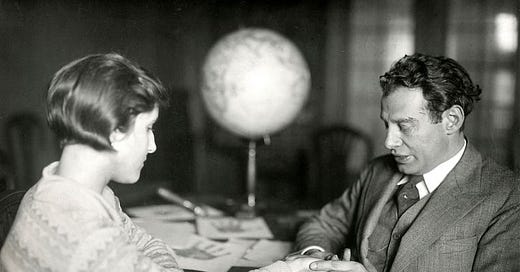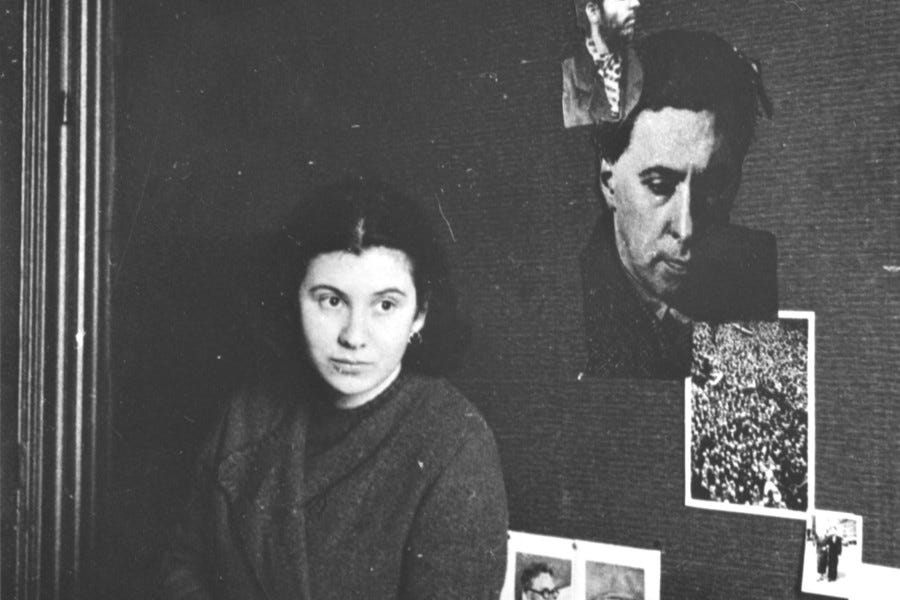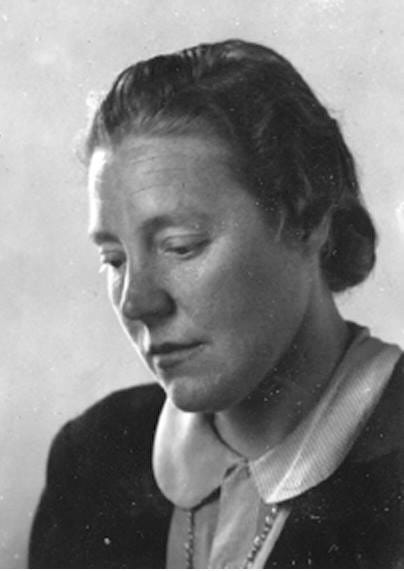Julius Spier read the Bible for guidance (Etty Hillesum followed him)
An article by Alexandra Nagel (PhD)
If you listened to the latest episode of Psychology & The Cross and got interested in the Jungian hand reader Julius Spier this article is for you. Alexandra Nagel who I interviewed for the podcast has written a beautiful essay on Spier’s reading of the Bible, what guidance he found there and how it inspired also Etty Hillesum.
There is also a PDF version to download of the article below. It contains footnotes as well as some additional illustrations and photos.
Julius Spier read the Bible for guidance (Etty Hillesum followed him)
One of the reasons that the writings of the Jewish diarist Etty Hillesum have been widely read and studied in Christian circles is the fact that she drew inspiration from the Bible and her private notes bear witness to Biblical-mystical experiences. More than once her last surviving note has been quoted, ‘The Lord is my high tower’, written on a postcard on September 7, 1943, and thrown out of a freight train on its way to Auschwitz. Hillesum had opened her Bible at random and must have found solace in this passage. The Book of Books had inspired her, although less in comparison to the works of Rainer Maria Rilke, and she could mention it in the same breath with Rilke or Carl Gustav Jung. She plucked from the Old and New Testament, just as she plucked from Rilke, Jung, and a range of other authors.
Hillesum was familiar with the Bible, that is, the Hebrew Bible (Old Testament). Although her parents were not particularly religious, her erudite father knew the Scriptures well. Hillesum’s own reading in this work originated under the influence of Julius Spier. How strong the influence of her ‘Bible-reading friend’ has been, can be understood in more depth now that a notebook containing Bible citations and references to Bible passages has come to light. In this article, first the notebook is described, followed by a reflection on Spier’s interest in the Holy Scriptures. Then come a few remarks about two Christian books which we know Hillesum read, and which can now be linked more directly to Spier. In all of this, Spier’s friendship with Henny Tideman plays a major role.
Early 1941, Spier read the Bible intensively
Among Spier’s items which have survived the passage of time, there is a blank notebook with a colorful cloth cover (fig. 1). It was bought in Berlin at a shop selling drawing materials and office supplies. Twenty pages of this notebook are filled with notes in Spier’s own handwriting. Henny Tideman kept it after his passing. She stamped her own name in purple ink on the top right corner of the front page.
In addition to these private notes, the album contains two photos. One shows Spier on his fiftieth birthday sitting aside a table covered with presents. The other is a portrait picture of Spier, on which Tideman had written her parents’ address. Between the pages was three-quarters of a worn, double folded sheet of a weekly calendar detailing Monday 31 March to 5 April 1941 (fig. 2). On the back of this sheet, Spier scribbled:
Matthew 9:13:
‘It is kindness that I want, not animal sacrifices.’ I have not come to call respectable people, but outcasts.
Matth. 6/ Sermon on the Mount 5+6+7 on the prayer[.]
The notes on the first fifteen pages are also taken from, and referenced to, passages of the Lutherbibel 1912 mit Apocryphen, the version Spier read. The scribble on the back of the calendar sheet corresponds to one of the last of these citations. After two empty pages, two more pages follow with a few lines copied from volume 1 of the epistolary novel Hyperion (1797), which was written by the German romanticist and poet Friedrich Hölderlin. All but two of the notebook’s remaining pages are left blank. The two pages at the very end contain a handful of notes related to music and Jung.
Spier’s handwriting in all these notes varies. Sometimes it is regular and reasonably legible, sometimes it is sloppy and difficult to decipher. As the “Bible pages” progress, the notes become more and more limited to references.
Putting the various pieces together, it is plausible that Spier received the notebook as a gift for his fiftieth birthday, on April 25, 1937, when he was living in two rented rooms in Berlin. Only in late 1940 or early 1941, he began to use it and did so until approximately May 1941. Coincidentally, this is exactly the period in which Etty Hillesum entered Spier’s life. The notes on the last two pages imply that at some point he used the notebook (also) for a purpose other than to copy passages from the Bible or Hyperion.
It is unknown whether Spier initially read the Old and New Testament from beginning to end or at random, and how he came to highlight the passages dotted down in the notebook. Nonetheless, his notes testify to a random reading: their order is not in sync with the Bible’s order. What is remarkable is his interest in the Deuterocanonical books. Besides references to the Letter to James, Corinthians 1 and 2, Isaiah and others, there are references to Tobit, the Book of Wisdom, Baruch and the Wisdom of Sirach. Clearly, he cited from the last most often. Illustrative is a menu card that was prepared for a small private dinner on February 22, 1942, to celebrate Spier’s “third Dutch birthday” (fig. 3). Having settled in Amsterdam in February 1939, Spier had been living in the Netherlands for three years. Cited above the menu – consisting of a raw vegetable dish, brown bean soup, rabbit with potatoes and red cabbage, and chocolate pudding – is Sirach 6:16-17:
A loyal friend is like a medicine that keeps you in good health. Only those who fear the Lord can find such a friend. A person who fears the Lord can make real friendships, because he will treat his friends as he does himself.
The dinner for seven held at Henny Tideman’s home was preceded by an afternoon of making music together. Those present included the organist Evaristos Glassner, who usually accompanied Spier’s singing on the piano. Glassner knew that Johannes Brahm’s Vier Ernste Gesänge was part of Spier’s singing repertoire. The lyrics of the third of these four “serious” songs based upon Biblical verses are based on Sirach 41:1-2, O death, how bitter you are....
Spier began to read the Bible under the influence of Tideman
The fact that Spier began to read the Bible was a direct result of his developing friendship with Henriëtte Maria (Henny) Tideman. The two had met by chance at the end of September 1939. Spier had shown interest in Tideman but indicated that he did not want an intimate relationship because of his engagement to Herta Levi, a German-Jewish refugee living in London. Subsequently a platonic friendship developed between them, a friendship based on their mutual love for music and walking, Tideman’s interest in psychochirology, and Spier’s interest in the Christian faith.
At the time, Tideman was strongly inspired by the Oxford group. This international revival movement of Christian origin, founded by the American preacher Frank Buchman, experienced a strong growth in the Netherlands in the late 1930s. People regularly gathered in small, close-knit groups. They favored a radical, social change, which had to come from within the individual. Most likely the Oxford group’s ideas about “change from within”, and “quiet time”, i.e. taking time to turn inward and to “listen to the God within”, appealed to Spier. They will have been the subject of conversation with Tideman.
Tideman’s private notes about her friendship with Spier show that she was very happy to have been allowed to lead Spier the ‘Way to God and Jesus Christ’. According to her, Christ had taken on meaning in Spier’s life. Proof of her conviction was embedded in a dream Spier had shortly before his death; in this dream he had been baptized by Christ. Hillesum referred to it in her diary on the evening Spier’s last breath left his body: ‘And you also once said, “I have such strange dreams, I dreamed that Christ himself came to baptize me.”’ However, even though the Bible and the Christian faith had become significant to Spier, his “conversion” to Christianity must be seen as wishful thinking on Tideman’s side. Notwithstanding Spier’s interest in Christian thought and his plea in a discussion with Werner Levie to read the Bible, this does not prove that he had become a devout Christian during the last phase of his life. The fact is that through his friendship with Tideman he had begun to read the Bible seriously. Yet the fact is also that he had come into contact with Christian thought long before he met Tideman.
Spier’s former wife, Hedel Rocco, was born into a Christian family. Julius and Hedel Spier-Rocco were not particularly religious and open towards ideas of movements such as anthroposophy; occasionally they consulted astrologers and alternative healers. Within a rather fluid religious milieu, the couple decided at some point to have their children baptized at home by an evangelical priest. At the time, daughter Ruth was seven years old, son Wolfgang was five. According to Spier’s children, their father’s Jewishness and their own “half-Jewishness” never played a role in their upbringing. That is, until anti-Semitism was on the rise and progressively more restrictions became imposed on the Jews. For example, they do not remember that their father went to a synagogue, nor that he took them to it. Furthermore, Wolfgang Spier recalled having been liberated from Religionsunterricht (religious schooling) because his mother was ‘into the “Christengemeinschaft” (which was somehow connected to Anthroposophy’.
In 1926, Iris-Verlag, the company Spier had founded a year earlier, published a new edition of Heilige Seelenlust (literally, The Soul’s Holy Desires, 1657) by the German mystic Angelus Silesius (the monastic name of Johannes Scheffler, 1624-1677). The book’s afterword was written by a family friend of the Spiers, Reinhold Zickel. It is possible that Zickel had introduced Silesius to Spier. Now, during the 1940 Christmas holidays, Spier reread Silesius’ Heilige Seelenlust, and he was just as moved by the text as he had been in 1926. So shortly after New Year’s eve he brought the book to the attention of Johan van Tricht. Would it not be nice if the book was translated to Dutch, Spier suggested to the owner of a publishing company in Arnhem. Van Tricht declined, but this is beside the point here, which is that Spier was exposed to Christian literature long before he met Tideman.
Spier derived support and reassurance from the Bible
The sentences from and the references to particular Bible passages that Spier copied into his notebook must for whatever reason have captured his attention. In these notes he comes across as a man looking for understanding, for guidance for rightful or good living, and justice. Spier’s following five citations support this impression:
James 2 (...)
20-22: Do you want to be shown that faith without actions is useless? How was our ancestor Abraham put right with God? It was through his actions, when he offered his son Isaac on the altar. Can’t you see? His faith and his actions worked together; his faith was made perfect through his actions.
Lamentations 3
26: So it is best for us to wait in patience – to wait for him to save us –
27: And it is best to learn this patience in our youth.
28: When we suffer, we should sit alone in silent patience;
29 We should bow in submission, for there may still be hope.
Hebrews 2
17-18: This means that he had to become like his brothers and sisters in every way, in order to be their faithful and merciful High Priest in his service to God, so that the people’s sins would be forgiven. And now he can help those who are tempted, because he himself was tempted and suffered.
2 Corinthians (...) 4
17-18: And this small and temporary trouble we suffer will bring us a tremendous and eternal glory, much greater than the trouble. For we fix our attention, not on things that are seen, but on things that are unseen. What can be seen lasts only for a time, but what cannot be seen lasts forever.
Matthew (...) 12
31: And so I tell you that people can be forgiven any sin and any evil thing they say; but whoever says evil things against the Holy Spirit will not be forgiven.
The themes implied in the quotes, such as right action, patience, and forgiveness, easily associate with the suffering inflicted on the Jews by the Nazi regime. The Jewish fate was also affecting Spier’s private life. Under the guise that it would be better for the children – they were “semi-Aryans” aka “half Jews” – Hedel Rocco explained the divorce to them. Also, to work was made impossible for Jews in Germany, including for Spier. Some of his Jewish friends and acquaintances had already fled the country. When he wanted to visit the UK in November 1939, he was unable to obtain a travel permit because he was registered as a Jew. Moreover, getting his manuscript Kinderhände published, seemed impossible. It was eventually published as The Hands of Children: An Introduction to Psycho-Chirology, posthumously, in 1944.
Notwithstanding such setbacks, Spier merely acted, or so it seems, with mercy and a desire not to fall into evil or sin. Every person has the opportunity to choose for the higher good and mercifulness, he reasoned. Even if someone had chosen the opposite path – that is, behaved evilly or sinfully – this was not by definition an indemnity for him to behave unmercifully to that person.
This kind of view was already put into practice by Spier long before he began to read the Bible in Amsterdam. Ruth and Wolfgang Spier shared a story that, to them, was characteristic of their father. It took place after their parents’ divorce in March 1935. Hedel Rocco was severely giving out to both Julius and the children because of their Jewish descent. However, Spier had shown understanding for their mother’s behavior, and tried to explain this to them. Hedel Rocco was an intellectual woman yet unstable. ‘It wasn’t her fault that she acts extremely harshly and resentful since the divorce’, Spier had stated time and again, ‘it was something in her nature and it did not make her a bad mother’. According to Ruth Busse-Spier, her mother had begun a relationship with a man twenty-five years younger out of a revengeful reaction to the divorce, although at the same time she had genuine feelings of love for this man. It had made life difficult for Ruth and Wolfgang, so in 1936 they moved out to live on their own. Spier had supported them financially. They visited their father weekly, and often the difficulties with their mother was a topic of their conversations. Yet their father had always pointed out to them to be mindful in their judgments about her.
The second story, told by a friend of Spier’s, involves a Nazi official. In order to emigrate legally to the Netherlands, Spier had to show a customs officer what he wanted to take with him. The man saw a collection of handprints and was puzzled. He was only familiar with the police study of fingerprints in criminal cases. When Spier had explained his work to the officer, the man had shown him his hands. And after Spier’s reading of them, the officer had begged Spier to stay a day or two longer in the country so he could bring his wife to meet him the following day. A Nazi who asked a Jew a favor, and a Jew interested in the hands of a Nazi-officer! The Spier children, aware of the story, retold it more than once.
In both examples, Spier emerges as someone who wanted to look at his fellow man as a person, an individual. Complemented by several other accounts, it can be argued that Spier observed the person who came to him for advice as someone with strengths and weaknesses. He was always willing to help the one seeking his council, so that he or she could bring out the best of him- or herself. With this mindset, Spier must have studied the Bible and have had an eye for passages that confirmed his own view of man, God, or the world. Undoubtedly, both aspects reinforced each other, meaning that Spier will have read Bible passages that justified and strengthened his behavior, but also pick up on those that inspired him even further. It therefore comes as no surprise that we find a similar example about a Gestapo officer in Etty Hillesum’s diary.
Early January 1942 Spier had an appointment at the Jewish Council in Amsterdam regarding some tax matters. Dreading the appointment, he had asked Hillesum, or Tideman – but she had other duties that day –, to accompany him. Afterwards, Hillesum described how one of the two officers had a ‘[s]ensitive, weak, intelligent face’, the other a ‘marvelously sardonic Mephistophelean head’. Surprisingly, the man with the ‘sharp, sardonic features’ had recognized Spier and warned the ‘weak face’: ‘Watch out for Mr. S., he can tell everything about you. From your hands.’ Immediately the sensitive young man had opened his hand whereupon Spier told him what he perceived of him. Within minutes, he was ‘bowled over’ and in ‘utter astonishment’ about the insights Spier gave him about himself. As soon as an appointment was set for a private consultation, the man had numerous tips of advice for Spier to fill out the required forms. In other words, the dreaded trip to the Jewish Council had turned into a genuinely nice meeting. Fate had chipped in. One official had recognized Spier and pointed out Spier’s profession. Also, Spier had managed to change his reluctant mood about having to talk finances into professional behavior. Once concentrated on the other as a person, the “nasty other” had on the spot become an “ordinary other”, an individual with his own characteristics.
Spier was a role model for Hillesum
Impressed by and deeply in love with Julius Spier, Etty Hillesum was hungry for all Spier read and did and knew. She learned to study hands, immersed herself in Jung, and attended the occasions where Spier and others played music together. She typed his letters and soon after her first meetings with him, she began to read the Bible. As early as March 13, 1941, there is a reference in her diary to 2 Corinthians 5:5. Scattered on three different places are references to the Gospel of John. 1 Corinthians appealed to her; on February 27, 1942 she read its verse 13 ‘for the umpteenth time’. In April that year she systematically read the Gospel of Matthew. At the end of June 1942 she decided that every morning she would read a piece of the Old Testament ‘on an empty stomach’. We know of a time when she stayed with Spier that they read a few Psalms together in the morning, and she considered the Bible ‘really an incredibly exciting book’.
There is no significant demonstrable overlap between Spier’s Biblical notes and the references and Hillesum’s writings. Corinthians can be found in both, Matthew, Job and Isaiah as well. On the other hand, Jesus Sirach and the other Deuterocanonical books are not mentioned by Hillesum. Apparently, she did not follow her dear friend in everything. An obvious reason why she did not refer to the Deuterocanonical writings is that those were not included in her Bible, the King James version, and she apparently made no effort to pick up a Roman Catholic version in which they were included.
Yet, Hillesum followed Spier sometimes in more depth than has been anticipated by many. Henny Tideman pointed out several of Hillesum’s sayings that, according to her – and others who had known Spier –, had found their origin in Spier. There are two other works, in which Spier’s influence can be found. Hillesum mentioned both, and both are known to have been of interest to Spier.
The first is Briefe über das Johannesevangelium (Letters about the Gospel of John, 1930/1932) by Friedrich Rittelmeyer. Jet Rümke-Everts gave it to Spier as a gift in May 1941. In 1922 Rittelmeyer had founded the Christengemeinde (Christian Community), a movement with close ties to anthroposophy. According to Rümke-Everts, Spier, whom she had met in October 1934 and whom she found to be a religious man, loved Briefe über das Johannesevangelium. Hillesum copied a number of sentences of it in her diary on June 13, 1941, and marked large parts of the copy that is now kept in the Jewish Historical Museum in Amsterdam. Spier recommended several passages of it in his single surviving letter to Hillesum.
The second work concerns Geheel voor hem: Overdenkingen voor elken dag (1935; translated from the English My Utmost for His Highest) by Oswald J. Chambers, at the time a popular Scottish clergyman and teacher. On June 17, 1942, Spier quoted a few words from this book in a letter to Leonie Snatager:
I am now reading the following in a book by Oswald Chambers:
‘There are times when there is no illumination and no thrill, but just the daily routine, the common task. Routine is God’s way of saving us between our times of inspiration tension. Do not expect God always to give you his thrilling minutes, but learn to live in the domain of drudgery by the power God.’
With the passage Spier intended to explain a subject that Snatager had written about in connection to her therapy with him. As Spier’s secretary, Hillesum had typed this letter upon Spier’s dictation. The following day, she copied the Chamber passage in her diary.
It is highly likely that Hillesum was receptive to these two authors, because Spier had read and referred to them, especially since other Christian works entered her path through Spier as well. An example is The Gospel of the Holy Twelve translated to Dutch in 1938 by N.M.C. Tideman (most likely an extended family member of Henny Tideman). Spier had copies typed to offer these as gifts for Christmas 1941. Two other works concern The Gospel of the Perfect Life by the preacher G.J. Ouseley, and the German translation of the Confessiones of Augustine: Des Heiligen Augustin Bekenntnisse.
Tideman’s faith was a source of inspiration for Spier and Hillesum
To summarize: Julius Spier was open to the Judeo-Christian Bible and works with a Christian signature. Fascinated by Spier, Etty Hillesum followed many of his footsteps. She absorbed Spier’s interest in Christian thought and internalized it so that it became entirely her own. With regard to Spier’s religious influence on Hillesum, however, it ought to be noted that an important influence of Henny Tideman was exerted on Spier. Except for the fact that Tideman inspired him to read the Bible, it is plausible, for example, that she handed him the Dutch translation of Chambers’ My Utmost for His Highest, for Chambers was widely read in Oxford circles.
In the documentary created by Jaap Walvis in 1984, Henny Tideman is seen to refute the prevailing opinion at the time that she had a major influence on Hillesum because of her Christian faith. Yet, she was willing to confirm that she had a major influence on the development of Spier. Ria van den Brandt rightfully argued, meanwhile building on Denise de Costa’s perceptiveness, that Tideman underestimated her own influence on Hillesum. Both de Costa and van den Brandt highlighted Tideman’s influence on Hillesum through her “lived” religiosity. In their view, this influence was not so much related to, as Van den Brandt put it, ‘specific contents of faith’, but to Tideman’s ‘religious perseverance and the opportunity she offered to exchange religious feelings’. Tideman’s statement that she was willing to acknowledge her influence on Spier’s faith relates precisely to “faith content”. Not mentioned by van den Brandt is Tideman’s comment in Walvis’ documentary that she acknowledged an influence on Hillesum’s development of faith through Spier. This is also related to “faith content”.
By the time the documentary was made and Tideman interviewed, she had forgotten that around September 1942, when Spier became very ill and died, a genuine friendship had developed between her and Hillesum. During the early 1980s Tideman was convinced that she had never been a friend of Hillesum’s. According to her memory, she had ‘almost forgotten about Etty’ when Het verstoorde leven (Interrupted Life, 1981) was published, ‘but not so about Julius Spier’. In other words, later in life Tideman failed to notice that she may also have had a direct influence on Hillesum’s faith, and that this influence was precisely in the area of religious experience.
In the above it is argued that studying the Judeo-Christian Bible would have strengthened Spier in his already existing people-loving, compassionate view of life. The examples offered to illustrate this are of a practical nature in the sense that the examples show something of Spier’s day-to-day dealings with people.
In Etty Hillesum’s diary entries we see how she was inspired time and again by Spier’s way of living and reading, and that, like Spier, she quoted from the Bible to give textual content to love and compassion. On one occasion Hillesum also talked about a Nazi official, ‘a disgruntled young Gestapo officer’, with whom she would have liked to start a psychological treatment. In order to become who she became, Hillesum gained not only inspiration from Spier to read the Bible and other Christian sources, but he was a living example putting the wisdom of such books into practice in daily life.








